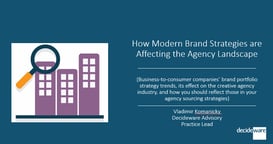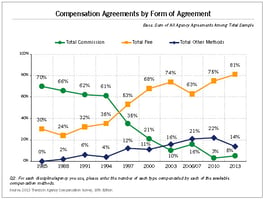The Decideware Advertising Management Scholarship at MSU. Decideware is pleased to announce a new...
How Modern Brand Strategies are Affecting the Agency Landscape (Pt 4)

This is the first article in a series of excerpts from our paper on How Modern Brand Strategies are Affecting the Agency Landscape. The article discusses business-to-consumer companies’ brand portfolio strategy trends, its effect on the creative agency industry, and how you should reflect those in your agency sourcing strategies.
What this Means for your Agency Sourcing Approach and Strategy
Whether you’re managing agency relationships in one of the large global multinationals or working for a smaller advertiser, it’s vital that you understand what is happening in the market and how to adjust your approach to successfully managing your agency landscape.
Although every company is unique, with corporate policies and culture needing to be considered, there are some common steps you can undertake to mitigate the risks posed by this shifting environment.
You should look to avoid surprises, such as your lead agency resigning your accounts and/or losing a critical amount of business that negatively affects their performance. As a precaution, you should review your lead agencies’ client list and the % of income generated by their top 5-10 clients, in order to determine if you could be facing any risks based on their clients’ currently known brand portfolio divestments, or through high dependency on a single account. If you believe you are potentially exposed to any risks, talk to your agency about their mitigation strategy and plan.
As highlighted in this article, the skills required from your agencies are constantly shifting. You should ensure that you have a clear lead-agency strategy in place – i.e. Integrated or Channel-specific agency solutions – and that you have the right capability within the agencies themselves, as well as in the specific teams working on your account.
The agency business is about relationships. Therefore, if agencies see you as a fair and prospective client, they will do everything to ensure that the account works well. Fair and prospective clients are those who stretch their agencies by giving them great assignments and challenging goals, who treat agencies fairly and who actively seek long-term win-win relationship. One recommendation is to enable such a cooperation by implementing, (at least), a 180° evaluation/feedback process (Agency-to-Client and Client-to-Agency), and ensure this is part of a broader strategically focused agency relationship management program. This will help you to best shape your relationship strategy and assist you to uncover and mitigate any potential issues early.
On the commercial side, you should implement, and consistently review, a fair and transparent remuneration model, looking to reward each Agency for great work and for hitting their targets. On the other hand, there should be a commercial downside for the agency in such an arrangement, in cases of non-delivery, in order to protect your business. Agencies should be commercially benefiting (or disadvantaged) from your success, especially those who have a material influence over your marketing strategy.
And lastly, ensure you can clearly interpret all your data outputs. Build a business intelligence capability and capacity to ensure that you can get qualitative feedback based on good interpretation of your data to enable great decision-making.
It’s not simple to develop and implement strong agency relationship management framework, but those business that do, will set themselves up for success.




